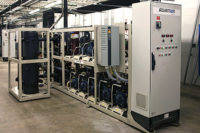The refrigerant is being used in a mechanical refrigeration system for Nestle’s state-of-the-art frozen foods plant in Jonesboro, AR.
The system uses CO2 technology from engineering company Praxair, Danbury, CT. The setup allows food processors to operate freezing systems at temperatures below those used in traditional ammonia-based refrigeration systems.
The Jonesboro facility will produce Stouffers® and Lean Cuisine® frozen meals in a 325,000-sq-ft space. It is expected to go on-line in early 2003.
Ron Roettger, Nestle’s director of engineering for U.S. prepared foods, said, “We at Nestle are excited about working with Praxair to implement this innovative refrigeration technology.”
Praxair described CO2 as “a tasteless, colorless, odorless, nonflammable, liquefied gas. Carbon dioxide is an integral part of the basic life cycle in nature. It is exhaled by humans and animals, then used by plants to help them grow. Plants, in turn, release oxygen, which people depend on for survival.
“Unlike atmospheric gases, air separation is not the primary source of carbon dioxide. Though sometimes it is derived from directly combusting a fuel, the most economical way to produce carbon dioxide is to recover it as a byproduct from other companies’ manufacturing processes or from natural wells. Then it is purified and liquefied and sold to our customers worldwide.”
Its use in mechanical refrigeration is a newer development. As Praxair noted, “Storage of carbon dioxide at its triple point (the temperature-pressure combination at which carbon dioxide can exist simultaneously as a solid, liquid, or gas) is being tested as a means of providing closed-loop refrigeration in order to shift electrical energy demand to off-peak consumption hours. The process offers the potential to shift electrical load while maintaining temperatures as low as –60 degrees F.”
According to Michael Sinicropi, director of marketing for Praxair, “Our patented technology is another new offering in our portfolio of low-temperature freezing and chilling systems for the food industry. These offers help increase productivity while enabling processors to more easily comply with safety and environmental regulations.”
Publication date: 04/01/2002





